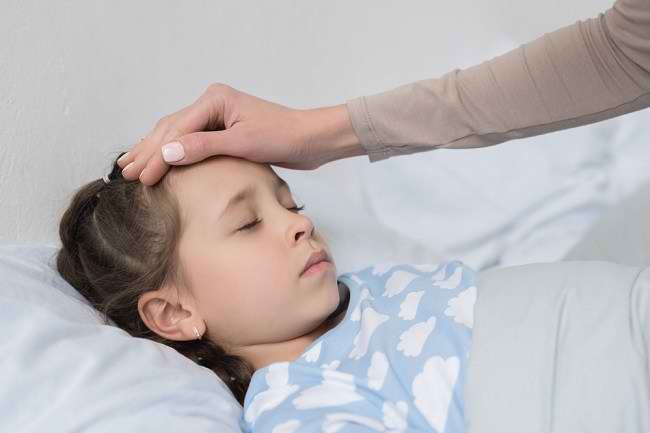Rheumatic fever in children generally occurs at the age of 5 to 15 years. Diseases caused by inflammation are complications of bacterial infections and can be fatal. Therefore, Ayou don't need to recognize symptomhis and how to handle it.
Rheumatic fever can cause inflammation in many organs of the body, from the brain, skin, joints, bones, to the heart. Rheumatic fever is a serious condition because if not treated properly, the sufferer can experience more severe health problems or even death.

These are the Symptoms of Rheumatic Fever in Children
Symptoms of rheumatic fever in children usually appear 2-4 weeks after the child has a sore throat or skin problem due to an untreated bacterial infection. Symptoms of rheumatic fever in children can include:
- Fever with a temperature above 38.5 degrees Celsius.
- The joints of the knees, elbows, and ankles and hands are swollen, red, painful, and warm to the touch.
- Body feels weak.
- Chest and stomach pain.
- Heart beating fast.
- Hard to breathe.
- Nosebleed.
- Red spots, rashes or patches appear on the skin. These patches can look like circles that are redder around the edges.
- The face, body, feet, and hands move or jerk by themselves.
- Behavior changes.
- Weight loss.
Immediately see a doctor if your child experiences the above symptoms. Rheumatic fever that is not treated immediately has the potential to cause several complications, such as brain and nerve disorders, heart valve disease, endocarditis, heart muscle damage, and even heart failure which can cause death.
How to Treat Rheumatic Fever in Children
To determine whether a child has rheumatic fever, a complete examination by a doctor is required which includes a physical examination and investigations, such as blood tests, sputum cultures, and echocardiography (ultrasound of the heart). If the diagnosis has been confirmed, then treatment of rheumatic fever should be given immediately.
Handling rheumatic fever in each child is not always the same. Generally, doctors will treat rheumatic fever in children based on the age, severity of symptoms, and the child's general health condition.
But basically, the treatment is aimed at killing bacteria or overcoming the remaining infection that causes inflammation, overcoming the symptoms of rheumatic fever, as well as preventing the emergence of dangerous complications.
The following are some steps to treat rheumatic fever:
Administration of antibiotics
Antibiotics function to kill the bacteria that cause inflammation in rheumatic fever. One type of antibiotic commonly used by doctors is penicillin which is given by injection.
After treatment with injectable antibiotics to kill bacteria is complete, the doctor will also prescribe another type of antibiotic to prevent repeated infections. This type of antibiotic can be taken by mouth.
Administration of anti-inflammatory drugs
In addition to antibiotics, the doctor will prescribe anti-inflammatory drugs (anti-inflammatory) to relieve the inflammatory process, fever, and pain experienced by children with rheumatic fever.
Anti-inflammatory drugs also play a role in preventing heart damage from rheumatic fever. Examples of these drugs are aspirin and corticosteroids.
Antique medicinegecko
In cases where the child experiences severe uncontrollable movements or convulsions, the doctor will prescribe anticonvulsants (anticonvulsants). Valproic acid and carbamazepine is an example of an anticonvulsant drug that is often prescribed by a doctor.
If you are already experiencing symptoms of heart problems, the doctor will also give you other medicines, such as diuretics and diuretics digoxin, to overcome heart problems that occur.
In addition to giving medicine from the doctor, you also have to make sure your little one gets enough rest to speed up recovery. If your little one seems very weak and won't eat or drink, he or she may need to be hospitalized to get fluids through an IV.
Rheumatic Fever Prevention Steps
The most effective way to prevent rheumatic fever in children is to treat bacterial infections that cause inflammation. Therefore, it is important to see a doctor when the symptoms of a bacterial infection begin, such as a sore throat or skin infection, are important.
In addition to dealing with the cause, there are several things that you also need to pay attention to in order to prevent rheumatic fever in children, namely:
- Keep children from coming into contact with sick people.
- Familiarize children not to share the use of personal items with others, such as eating utensils.
- Teach and familiarize children to wash their hands.
- Teach your child to always cover his mouth with his hand or handkerchief when he coughs or sneezes.
In addition, do regular checkups to the pediatrician according to the specified schedule. This is useful for monitoring the health condition of children and anticipating the occurrence of rheumatic fever due to bacterial infection.









